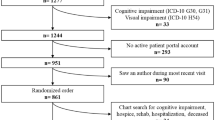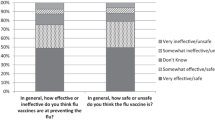Abstract
OBJECTIVE: To characterize U.S. physicians’ practices regarding influenza vaccine, particularly regarding the capacity to identify high-risk patients, the use of reminder systems, and the typical period of administration of vaccine.
DESIGN: Cross-sectional mail survey administered in October and November 2000.
PARTICIPANTS: National random sample of internists and family physicians (N=1,606).
RESULTS: Response rate was 60%. Family physicians are significantly more likely than internists to administer influenza vaccine in their practices (82% vs 76%; P<.05). Eighty percent of physicians typically administer influenza vaccine for 3 to 5 months, but only 27% continue administering vaccine after the typical national peak of influenza activity. Only one half of physicians said their practices are able to generate lists of patients with chronic illnesses at high risk for complications of influenza, and only one quarter had used mail or telephone reminder systems to contact high-risk patients. Physicians working in a physician network (including managed care organizations) are more than twice as likely to use reminders as physicians in other practice settings (odds ratio, 2.04; 95% confidence interval, 1.17 to 3.55).
CONCLUSIONS: Over three quarters of U.S. internists and family physicians routinely administer influenza vaccine, but few continue immunization efforts past the typical national peak of influenza activity. Many physicians may be limited by their practice data systems’ capacity to identify high-risk patients. Despite the known effectiveness and cost-effectiveness of reminder systems, few physicians use reminders for influenza vaccination efforts. These findings raise concerns about meeting domestic influenza vaccination goals—especially for individuals with chronic illness and during periods of delayed vaccine availability—and the possibility of increased morbidity and mortality attributable to influenza as a result.
Similar content being viewed by others
References
Centers for Disease Control and Prevention. Prevention and control of influenza recommendations of the Advisory Committee on Immunization Practices (ACIP). Morb Mortal Wkly Rep. 2000;49:1–38.
Centers for Disease Control and Prevention. Influenza, pneumococcal, and tetanus toxoid vaccination of adults — United States, 1993–1997. Morb Mortal Wkly Rep. 2000;49:39–62.
Centers for Disease Control and Prevention. Delayed supply of influenza vaccine and adjunct ACIP influenza vaccine recommendations for the 2000–01 influenza season. Morb Mortal Wkly Rep. 2000;49:619–22.
Centers for Disease Control and Prevention. Updated recommendations from the Advisory Committee on Immunization Practices in response to delays in supply of influenza vaccine for the 2000–01 season. Morb Mortal Wkly Rep. 2000;49:888–92.
Centers for Disease Control and Prevention. Delayed influenza vaccine availability for 2001–02 season and supplemental recommendations of the Advisory Committee on Immunization Practices. Morb Mortal Wkly Rep. 2001;50:582–5.
US Department of Health and Human Services. Healthy people 2000: National Health Promotion and Disease Prevention Objectives. Washington, DC: Public Health Service; 1991.
Centers for Disease Control and Prevention. Influenza and pneumococcal vaccination levels among persons aged ≥ 65 years — United States, 1999. Morb Mortal Wkly Rep. 2001;50:532–7.
US Department of Health and Human Services. Healthy people 2010: Objectives for Improving Health. Washington, DC: Public Health Service; 2000.
Singleton JA, Lu PJ, Strikas RA. Progress toward the Healthy People 2000 influenza vaccination objective, United States, 1997. In: Abstracts of the 34th National Immunization Conference, Atlanta, GA, 2000. Atlanta, GA: Centers for Disease Control and Prevention; 2000.
Smith DM, Zhou X-H, Weinberger M, Smith F, McDonald RC. Mailed reminders for area-wide influenza immunization: a randomized controlled trial. J Am Geriatr Soc. 1999;47:1–5.
Kellerman RK, Allred CT, Frisch LE. Enhancing influenza immunization: postcard and telephone reminders and the challenge of immunization site shift. Arch Fam Med. 2000;9:368–72.
Briss PA, Rodewald LR, Hinman AR, et al. Reviews of evidence regarding interventions to improve vaccination coverage in children, adolescents, and adults. Am J Prev Med. 2000;18:97S-140S.
Szilagyi PG, Bordley C, Vann JC, et al. Effect of patient reminder/recall interventions on immunization rates. JAMA. 2000;284:1820–7.
Szilagyi PG, Rodewald LE, Humiston SG, et al. Immunization practices of pediatricians and family physicians in the United States. Pediatrics. 1994;94:517–23.
Centers for Disease Control and Prevention. Influenza activity—United States, 2000–01 season. Morb Mortal Wkly Rep. 2000;49:1085–7.
Baker AM, McCarthy B, Gurley VF, Yood MU. Influenza immunization in a managed care organization. J Gen Intern Med. 1998;13:469–75.
Schneider EC, Cleary PD, Zaslavsky AM, Epstein AM. Racial disparity in influenza vaccination: does managed care narrow the gap between African-Americans and whites? JAMA. 2001;286:1506–9.
Centers for Disease Control and Prevention. Missed opportunities for pneumococcal and influenza vaccination of Medicare pneumonia inpatients—12 western states, 1995. Morb Mortal Wkly Rep. 1997;46:919–23.
Fedson DS. Adult immunization: summary of the National Vaccine Advisory Committee report. JAMA. 1994;272:1133–7.
American Board of Internal Medicine. Diplomates certified by state, as of January 22, 2001. Available at: http://www.abim.org/info/states.htm. Accessed March 1, 2002.
Poel AJ, Singleton JA, Wooten K. Where adults reported receiving influenza vaccination, US, 1998/1999. In: Abstracts of the 35th National Immunization Conference. Atlanta, Ga: Centers for Disease Control and Prevention; 2001.
Pathman DE, Konrad TR, Freed GL, Freeman VA, Koch GG. The awareness-to-adherence model of the steps to clinical guideline compliance. Med Care. 1996;34:873–89.
Cabana MD, Rand CS, Powe NR, et al. Why don’t physicians follow clinical practice guidelines? A framework for improvement. JAMA. 1999;282:1458–65.
Davis JW, Lee E, Taira D, Chung R. Influenza vaccination, hospitalizations, and costs among members of a Medicare managed care plan. Med Care. 2001;39:1273–80.
Bridges CB, Thompson WW, Meltzer MI, et al. Effectiveness and cost-benefit of influenza vaccination of healthy working adults. A randomized controlled trial. JAMA. 2000;284:1655–63.
Asch DA, Jedrziewski K, Christakis NA. Response rates to mailed surveys published in medical journals. J Clin Epidemiol. 1997;50:1129–36.
Cummings SM, Savitz LA, Konrad TR. Reported response rates to mailed physician questionnaires. Health Serv Res. 2001;35:1347–55.
Author information
Authors and Affiliations
Corresponding author
Additional information
This work was funded by the Centers for Disease Control and Prevention through a cooperative agreement with the Association of Teachers of Preventive Medicine.
Rights and permissions
About this article
Cite this article
Davis, M.M., McMahon, S.R., Santoli, J.M. et al. A national survey of physician practices regarding influenza vaccine. J GEN INTERN MED 17, 670–676 (2002). https://doi.org/10.1046/j.1525-1497.2002.11040.x
Issue Date:
DOI: https://doi.org/10.1046/j.1525-1497.2002.11040.x




